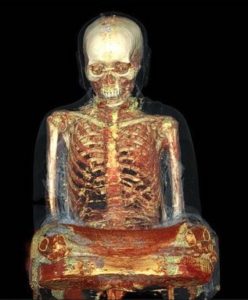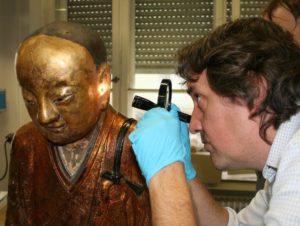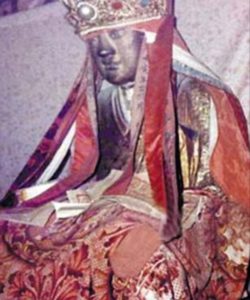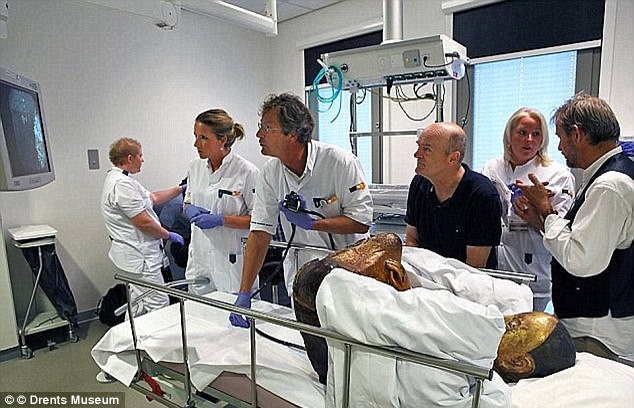A Dutch court decision on December 12, 2018 ended one chapter in the story of an unusual papier-mâché Buddhist statue containing a human mummy – but did not resolve a controversial situation or illuminate the path forward for the parties. On one side is a Dutch collector who claims to have purchased the statue in Holland from a previous Hong Kong owner, who had the statue in late 1994 or early 1995. On the other, are Chinese authorities and the representatives of a Chinese village, who state that it was stolen from a temple in 1995. The dispute, ongoing since 2015, appears to be even murkier and more contradictory than before.
The Dutch court was reviewing the claim of two Chinese villages, Yangchun and Dong Pu in southeastern Fujian province against the Dutch owner, Oscar van Overeem. The Dutch court did not decide anything about the ownership of the parties. It simply determined not to hear the case, based on its finding that the villages did not have standing to sue in the Dutch court.
An unusual ‘self-mummification’ process

Credit: ©Ben Heggelman (Meander Medical Centre, Amersfoort) / University Hospital Mannheim.
The statue itself was extraordinary not so much for its beauty or style, but because when it was first studied in Europe, researchers discovered that the hollow figure contained a human body. In 1996, van Overeem contacted a restorer to repair some chips and cracks in the exterior. When the restorer opened the bottom of the statue, he found two small pillows, and resting on the pillows, the body of a mummified monk. Initial radiocarbon testing found that the body was approximately 900 – 1000 years old. The textiles on which the body rested were found to be several hundred years older.
The statue was taken to the Meander Medical Center in Amersfoort in the Netherlands, where a full CT scan was performed and samples taken through endoscopy. The investigative team found scraps of paper on which Chinese characters were written, placed inside the body in the cavities normally containing organs. These identified the monk, depending on how the characters are interpreted, possibly as a monk known as Zang Liuquan.
China Daily countered the identification as follows:
The Dutch research team believes that the mummy may be a rare example of the “self-mummification” process, through which a monk attempted to achieve a higher spiritual state by a process which required a slow self-starvation, preparing the body for mummification by consuming a diet of roots, bark, resin and pine needles.
This diet was thought to remove fat and liquids, and to fill the body with toxins that would kill maggots and other insects, enabling the body’s preservation. Similar self-mummification processes have been practiced in Japan as well.
A museum show draws Chinese attention

View of mummy inside the statue. Credit: © Drents Museum.
The collector loaned the statue to the Drents Museum in Assen in the Netherlands for an exhibition, “Mummy World,” which traveled to the Hungarian Natural History Museum in 2015. Press reporting on the Hungarian exhibition alerted Chinese authorities. Researchers at the Fujian Cultural Relics Appraisal Center said in March 2015 that based on photographs from Hungary and archival materials in China, they believe the statue is one taken from the Yangchun village temple. The temple statue’s hollow body was said to have held the mummified remains of the village’s patriarch, Zhanggong Zushi, who lived during the Song dynasty (960-1279).
The same report stated that the collector had precipitately withdrawn the statue from the Hungarian exhibition, “in order to ‘calmly and critically evaluate the unexpected situation’.”
Inconclusive ending
Representatives of Yangchun village, in Fujian Province claim that the statue possessed by van Overeem is the same one that was stolen from a community temple that served both villages in 1995. Van Overeem said this was not possible because he had purchased the statue before the villages said it had been stolen.
Van Overeem was initially willing, in 2015, to send the statue back to China so long as it would be placed in a temple or monastery setting where it could “be incorporated in truly Buddhist surroundings” and worshiped “by those who love and appreciate him.” He declared he would not give it back to the Chinese government for placement in a State museum.

Yangchun statue as seen in temple.
In May 2015, van Overeem stated via social media that a tentative agreement had been reached whereby the statue would go to a major Buddhist temple, South Putuo Temple, in Xiamen city of Fujian province, near to the village claiming the statue. By December of that year, however, negotiations had broken down over the conditions van Overeem had placed on the statute’s return. He had asked for $20 million to recoup the cost of his twenty years of care and research into the statue. China Daily added that, “According to Xinhua News Agency, the collector wished to return the statue to South Putuo Temple, a millenium-old temple in Xiamen city of Fujian province. The Temple issued a certificate that they had never enshrined and worshipped any mummified Buddha statue in history and would not worship it in the future, but the collector still insisted to return the statue to that temple.”
In a strange twist to the tale, van Overeem told the court this week that he no longer possessed the statue, and could not say what had happened to it. He claimed that he was so upset by the controversy that the ownership of the statute generated that he had turned it over to a Chinese businessman, exchanging the statue and the mummified remains for a number of other statues with the unidentified man because the case had cost him ‘a lot of negative energy, money and business’.
The Yangchun village has hired Chinese and Dutch lawyers to petition the Dutch court for the statue’s return. They will likely appeal the Dutch court’s decision, arguing that in China a village committee is a “special legal person” under Chinese civil law. In the meantime, the statue’s whereabouts have not been made public.
The mummified body inside the statue is the only Chinese Buddhist mummy that has been scientifically studied in the West. But Van Overeem now says he does not know anything about the statue, and that he learned only the English name of the Chinese individual with whom he traded the statue. Because an agreement was not reached, it seems likely that research on the mummy will not continue, and it will no longer be accessible to the public.
 Researchers test mummy with endoscopy, copyright Drents Museum.
Researchers test mummy with endoscopy, copyright Drents Museum. 

